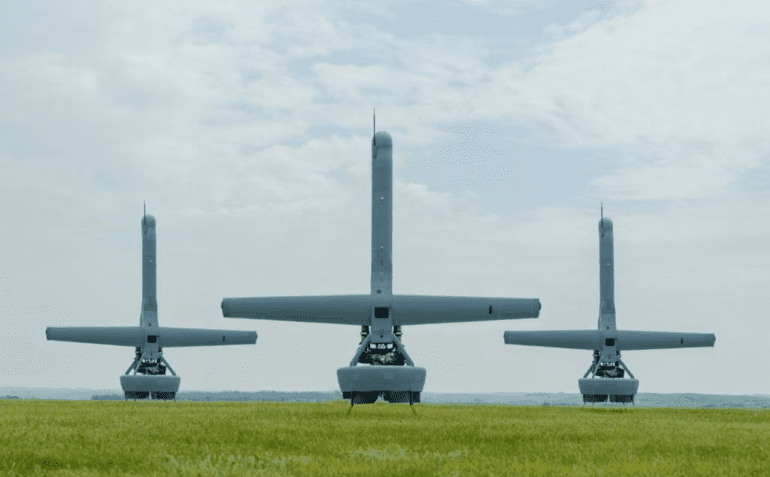TL;DR:
- Shield AI introduces V-Bat Teams, a drone swarm technology for high-threat environments.
- Powered by Hivemind AI pilot software, V-Bat Teams operate autonomously without GPS or communication guidance.
- Potential synergy with the Pentagon’s Replicator program, aiming to deploy autonomous drones to counter China.
- V-Bat Teams conducted successful flight and monitoring demonstrations in collaboration with the Air Force’s AFWERX unit.
- Expansion plans include scaling up V-Bat Teams’ capacity and diverse mission applications.
- Cost-effective V-Bats can act as decoys, protecting crewed aircraft.
- Shield AI aims to market V-Bat Teams to the U.S. military and international clients.
Main AI News:
California-based defense technology firm, has introduced its cutting-edge drone swarm technology known as V-Bat Teams. This innovative solution is poised to play a pivotal role in the Defense Department’s ambitious Replicator initiative. V-Bat Teams, a culmination of Shield AI’s collaboration with the Air Force’s AFWERX innovation unit, harnesses the power of the company’s advanced artificial intelligence pilot software, aptly named Hivemind. These teams, comprised of a small fleet of V-Bat aircraft, possess the remarkable capability to operate autonomously in high-threat environments, rendering GPS or communication guidance obsolete.
Brandon Tseng, the co-founder and president of Shield AI, expressed his optimism about the synergy between V-Bat Teams and the Pentagon’s Replicator program, which seeks to deploy thousands of autonomous, attritable drones within the next two years to counter China’s growing influence. Tseng emphasized that V-Bat Teams would require minimal human intervention, with humans primarily designating the target or mission. However, the V-Bats maintain the ability to alert operators when a situation demands their attention.
Shield AI marked a significant milestone in April with the maiden flight of V-Bat Teams, followed by a remarkable demonstration as part of the Air Force’s AFWERX autonomy initiative in June. This demonstration showcased the prowess of Hivemind technology, as it effortlessly launched and autonomously controlled a trio of V-Bats, effectively monitoring and surveilling simulated wildfires.
Currently, V-Bat Teams consist of four UAVs, with plans to double this capacity annually, reaching eight in 2024 and subsequently scaling to 16 and beyond. Tseng pointed out that Hivemind’s autonomous software has the potential to control even larger fleets of V-Bats. However, logistical challenges pertaining to launching and landing multiple drones concurrently are the limiting factors.
Tseng highlighted that deploying large drone swarms is not a novel concept, often seen at festivals and celebratory events. However, these conventional drones lack intelligence and security, making them vulnerable to disruption. Shield AI’s initial focus was to develop a sophisticated, secure AI pilot in the form of Hivemind before integrating additional drones to diversify their mission capabilities.
Initially, V-Bat Teams will be deployed for maritime domain awareness missions. Nevertheless, their utility extends to various applications, including the suppression of enemy air defenses, strike operations, escort missions, and logistics operations. Remarkably cost-effective, with a price point in the mid-six-figure range, V-Bats can even serve as decoys to divert enemy fire, safeguarding crewed aircraft from potential threats.
Tseng emphasized that V-Bats are attritable, meaning they can be deployed in substantial numbers, allowing the military to absorb losses while maintaining operational effectiveness. He drew attention to Ukraine’s experiences, underscoring the importance of intelligent and affordable mass deployment over sheer numbers.
Shield AI has ambitious plans to offer V-Bat Teams to all branches of the U.S. military and international customers, ushering in a new era of autonomous operations. Tseng anticipates that this proliferation of AI-driven aircraft will redefine the landscape of military operations, unlocking unprecedented possibilities.
However, when it comes to the Air Force’s vision of collaborative combat aircraft – autonomous drones operating alongside crewed fighters like the F-35 – Tseng indicated that Shield AI is open to exploration but acknowledged the distinct focus of the Air Force on AI-piloted jets. The integration of these jets with other platforms, such as V-Bat, remains a topic for future consideration.
Conclusion:
Shield AI’s V-Bat Teams represent a significant advancement in drone swarm technology. Their autonomous capabilities and versatility offer potential benefits for defense initiatives such as the Replicator program. The market can anticipate increased interest in AI-driven drone solutions, with potential applications spanning various defense scenarios and operations.

